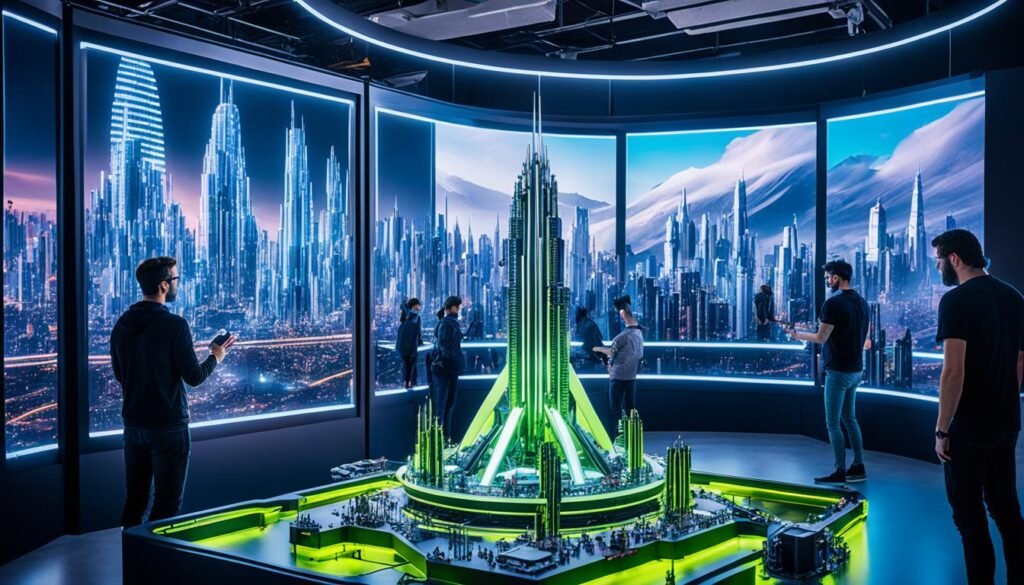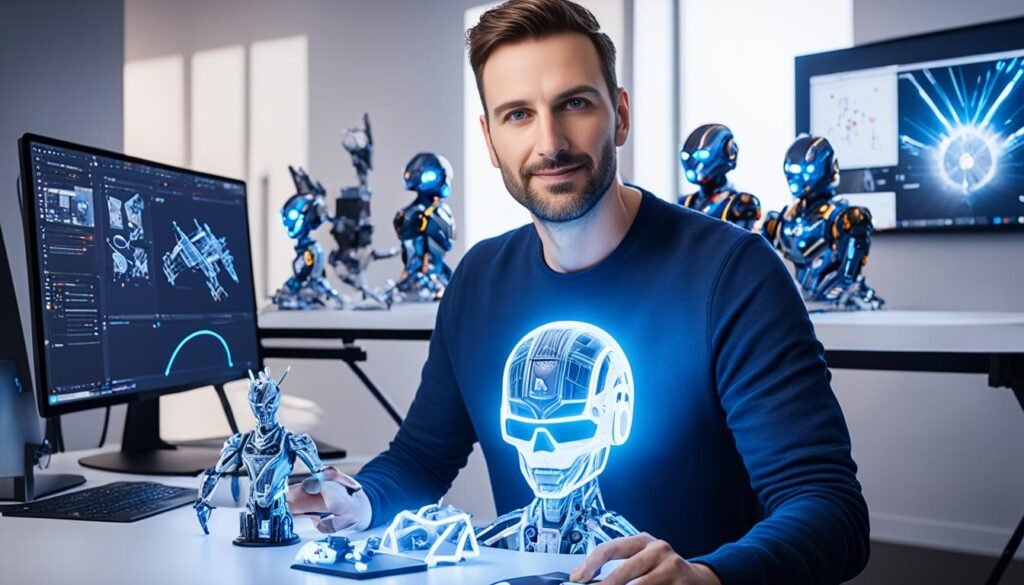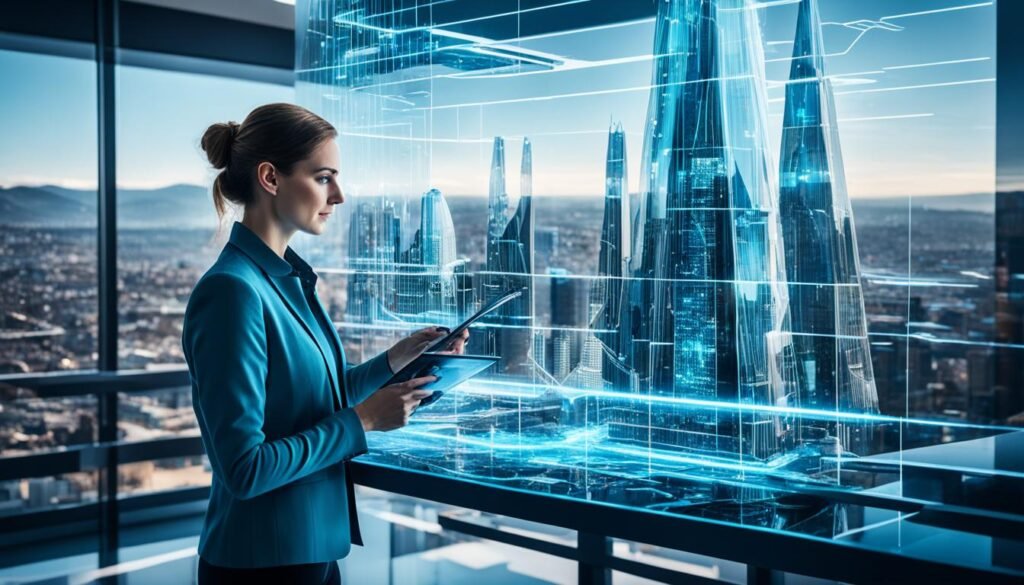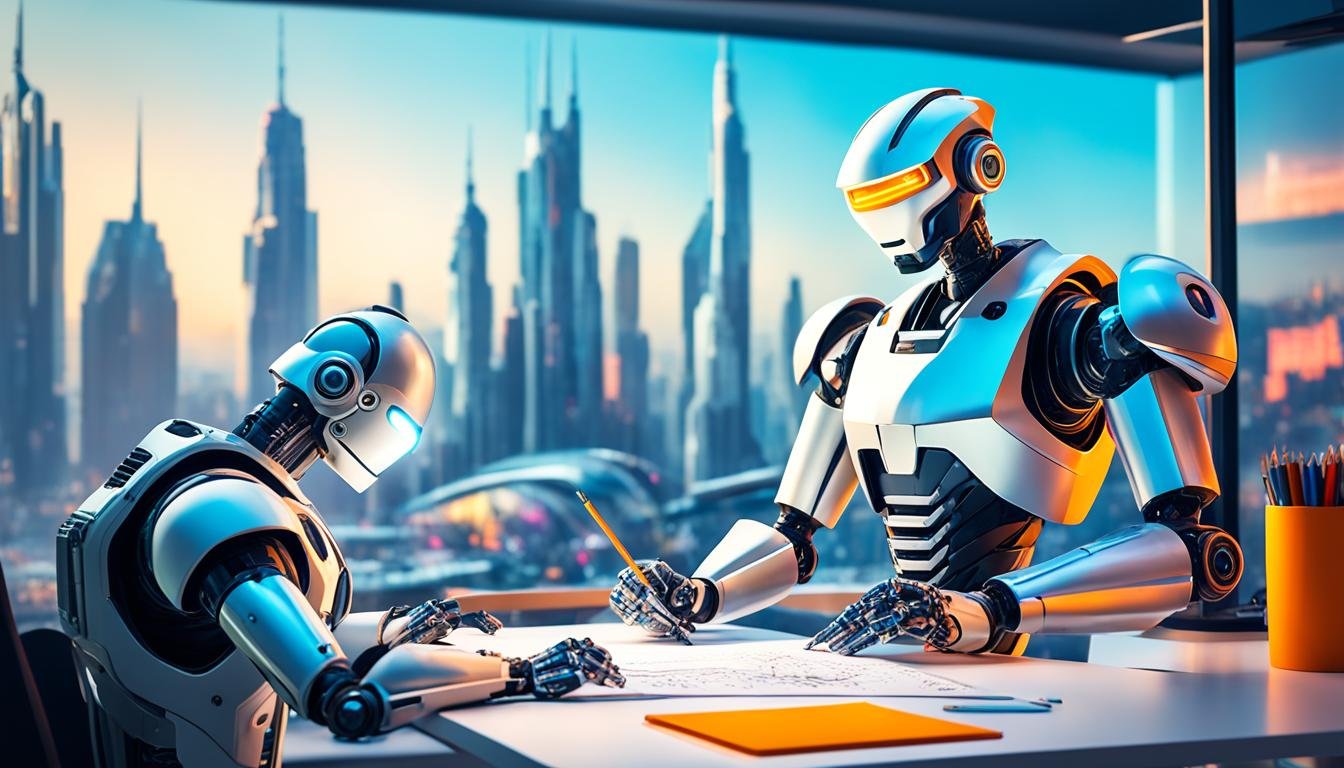Technology is changing how we create, making us wonder if AI will take over 3D artists’ jobs. A study found that 3D artists spend about 6 hours daily learning new software like Blender. But, only a tiny part of them can live off their art. This shows the big challenges in the 3D art world and how AI might change it.
AI is getting better and will likely change the 3D art world a lot. It might make making art faster and easier for some tasks. But, it can’t feel emotions like humans do. Also, while AI is great at doing the same thing over and over, artists need to be in charge for detailed work. This means the human touch is still key in making art.
As 3D art changes, learning to work with AI is vital for artists. AI tools are getting easier to use, letting people without special skills make 3D models. This makes us think about the future of 3D artists and if AI can really capture the creativity and beauty we see in human art.
Key Takeaways
- AI can speed up some 3D art tasks but can’t replace the human touch and feelings.
- Working together with AI tools is now key as the industry changes.
- We’re still debating if AI can really get the depth of human creativity and art.
- AI might make making some art less popular, but it can also make things more efficient and open up new creative ways.
- Adjusting to the new world and using AI in the 3D artist’s work will be important for success.
Understanding AI in 3D Art
The world of art and design is changing fast. Now, artificial intelligence (AI) in 3D art is a big part of that change. To get what AI does in 3D art, we need to know the basics of AI and its role in making art.
What is AI?
AI means making computers do things that usually need a human brain, like learning and solving problems. It uses special algorithms to learn from data, find patterns, and come up with new ideas.
How Does AI Work in 3D Art?
In 3D art, AI helps make the creative process easier and faster. Procedural generation using AI algorithms can make complex 3D models and scenes on its own. AI-driven physics simulation tools make animations look real by simulating how things move and interact. AI-powered tools in post-production tasks can also automate editing, like removing objects or improving pictures.
Shape-E is a cool AI model by OpenAI that can make 3D models quickly from text or images. It could change how designers and artists work with 3D models, offering new tools for learning and creating.
“Shape-E can create a chair resembling an avocado or an airplane resembling a banana, showcasing the versatility and creativity of this AI-powered 3D generation tool.”
As AI becomes more common in 3D art, artists and designers need to keep up. They should use these new tools to their advantage while still being true to their creative vision.

Popular AI Tools for 3D Art
3D art is evolving fast, and AI tools are becoming key for artists and designers. These tools are changing how we create, making things faster, more automated, and even letting us make 3D models from nothing. Let’s look at some top AI tools changing 3D art.
Text-to-3D Generators
Tools like 3DFY.ai and Masterpiece Studio’s AI 3D model generator, Masterpiece X – Generate let artists make 3D models with just text. They turn words into detailed 3D shapes, making modeling easier. Prices vary from $5 per model to $10.99 to $36.99 a month for subscriptions.
Image-to-3D Generators
Image-to-3D generators are also making waves in 3D art. LeiaPix and Luma AI’s video-to-3D model generator, Luma Genie turn 2D images into 3D models. This makes it easy for artists to create 3D assets from photos, changing how we work. Prices start at $5 for 500 credits.
AI-Assisted 3D Modeling
AI is also helping with traditional 3D modeling. Meshcapade focuses on AI digital humans, while RODIN Diffusion and Meshcapade make detailed 3D avatars from text or images. These tools automate boring tasks, letting artists focus on being creative.
As AI becomes more common in 3D art, we’re seeing more creativity, efficiency, and innovation. These tools are leading us into a new era of 3D art, where the line between human and machine is fading.

will ai replace 3d artists
In the world of 3D art, the debate about whether AI will replace human creativity is ongoing. AI tools are changing the industry, but the human touch is still key for making unique and engaging 3D designs.
Creativity and Innovation
AI can do some tasks like making 3D models or sketches, but it can’t match the creative spark of human artists. Tools like Midjourney, DALL-E 2, and Stable Diffusion make great images, but they use what we already know and don’t have the same creative spark as humans. Humans have a special skill in making 3D designs that really speak to people, something AI hasn’t mastered yet.
Understanding Human Needs and Desires
Good 3D design is more than just technical skill; it’s about knowing what users want and feel. AI can help with tasks like showing clients designs, but it misses the emotional and psychological depth that humans understand. Human artists have the empathy and insight to make 3D experiences that really touch people.
AI will keep getting better in the 3D art world, but it won’t replace human creativity, innovation, or focus on users. The best results come from combining AI with human creativity.
| AI vs. Human Creativity in 3D Art | Strengths | Limitations |
|---|---|---|
| AI |
|
|
| Human 3D Artists |
|
|
Integrating AI into the 3D Artist’s Workflow
The world of 3D art is changing fast, and AI is becoming a big part of it. By using AI tools, 3D artists can make their work faster, better, and more creative. This helps them give their clients amazing results.
Concept Development and Client Visualization
AI is really useful in the early stages of making 3D art. AI-powered concept development tools can quickly show ideas in visual form. This gives artists a good starting point to work from. It also means they can quickly show different ideas to clients, making it easier to get feedback.
Client visualization with AI is also key. AI helps artists make detailed, real-looking pictures of their ideas. This lets clients understand the designs better and give good feedback.
Reference Gathering and Portfolio Building
AI can also make things easier for 3D artists when finding references and building portfolios. AI can search for inspiring images and styles automatically. This saves artists time and lets them focus more on being creative.
Also, AI and 3D artist portfolio management tools can be really helpful. These tools organize and show off an artist’s best work in a neat way.
| AI Tool | Functionality | Benefits |
|---|---|---|
| Meshy.AI | Text-to-3D model generation | Rapid concept development, client visualization |
| 3D AI Studio | AI-assisted 3D modeling and sculpting | Enhanced efficiency, time-saving |
| LumaLabs Genie | AI-powered image generation and editing | Streamlined reference gathering, portfolio curation |
By using these AI tools, 3D artists can work more efficiently, be more creative, and make their clients happier. This helps them stay ahead in a changing industry.

“AI is not here to replace 3D artists, but rather to enhance their capabilities and allow them to focus on the more complex and creative aspects of their work.”
The Role of AI in Architecture
The architecture world is changing fast, and AI is playing a big part. AI is changing how architects work, especially in the beginning and when they divide tasks. Let’s see how AI is making architecture design better.
AI in Early Architectural Stages
AI is a big help in the early stages of design. It lets architects quickly try out ideas and see many different designs. This helps them make better choices and come up with new ideas.
AI also makes turning 2D sketches into 3D models easier. Tools like Shape-E use machine learning to create complex 3D models from text or images. This makes bringing ideas to life faster.
AI-Powered Task Delegation and Optimization
Architects have a lot to do, from talking to clients to managing projects. AI can help by doing repetitive tasks and assigning tasks. AI-powered task management systems can look at projects, set priorities, and check risks. This lets architects focus on creative and strategic work.
AI can also help architects make smart choices about energy use, materials, and sustainable design. By using AI, architects can make buildings that are good for the environment and save money. They also meet their clients’ needs better.

The future looks bright for architecture and AI. There are challenges like unpredictable AI results and needing updates, but architects are excited. They see AI as a way to improve design, make work easier, and create better buildings.
The Human Touch: What AI Can’t Replace
The world of human creativity in 3d art is always changing. It’s key to see the special things that humans add to 3D design. AI limitations in 3d design are clear, but human skills in 3d industry and the importance of human touch in 3d art are still vital.
AI tools like OpenAI’s DALL-E 2 and Microsoft Bing’s Image Creator are making waves in graphic design and digital stories. Yet, the human part in 3D art is still key and hard for AI to copy.
“AI lacks the human touch and fine details that distinguish the work of experienced graphic designers.”
AI can make images fast, but it can’t match the creativity and innovation of human artists. Humans understand what users need and add emotional nuances to designs that AI can’t.
The importance of human touch in 3d art goes beyond making art. People like products that show human effort because they want something unique and real.
As things change, finding the right mix of AI and human creativity will be key. The irreplaceable human skills in 3d industry will keep being crucial in the future of 3D design.
Future Trends and Possibilities
The future of AI in 3D art is full of exciting changes. One big area is using AI-powered virtual reality (VR) in 3D design. This tech could change how 3D artists think and see their work, making design more immersive and interactive.
There’s also a push to use AI for risk assessment and optimization in 3D work. AI can spot design problems or ways to do things better. This helps 3D artists make smarter choices and work more efficiently. It could save time and money, making 3D projects better overall.
| Trend | Impact | Timeline |
|---|---|---|
| AI-powered virtual reality for 3D design | Immersive and interactive design experiences | Next 5-10 years |
| AI risk assessment in 3D industry | Identifying design flaws and optimizing workflows | Next 3-5 years |
| AI optimization in 3D workflow | Increased productivity and quality of 3D projects | Next 3-5 years |
The future of AI in 3D art is always changing. 3D artists and designers need to keep up with these new technologies. By staying informed and flexible, they can use AI to boost their creativity and work better.
Conclusion
AI is changing the world of 3D art and design. It’s making AI-generated 3D art a reality. But, AI won’t replace human 3D artists anytime soon. The mix of human creativity and AI tools is key for new ideas and growth.
3D artists need to use AI in their work. AI can do repetitive tasks, make things more efficient, and help with creativity. This lets artists focus on the creative parts of their work. By working with AI, 3D artists can make new things, work better, and create more amazing art.
The 3D art world is always changing. We’ll see more teamwork between human creativity and AI skills. The role of 3D artists is to use AI tools to explore new possibilities in 3D art. By being open to AI, 3D artists will stay relevant and successful in this fast-changing field.
FAQ
What is AI and how does it work in the 3D art industry?
AI lets machines do tasks that need human smarts, like spotting patterns and making new info. In 3D art, AI tools make 3D models from text or images. They also help artists with tasks like fixing models and creating new versions.
What are some popular AI tools used by 3D artists?
Top AI tools for 3D art include text-to-3D tools like 3DFY.ai and image-to-3D tools like Spline. There are also AI tools for 3D modeling like NeROIC and Meshcapade.
Will AI replace 3D artists?
AI can do some tasks on its own, but it can’t match human creativity, understanding, or skills. It’s more likely to help 3D artists do their jobs better, not replace them.
How can 3D artists integrate AI into their workflow?
Artists can use AI to quickly bring ideas to life and get feedback from clients. They can also use it to find inspiration and build portfolios faster.
How can AI be used in the architecture industry?
AI is great for early design stages in architecture. It helps with making concept sketches and visualizations. It also helps architects sort tasks and check risks.
What aspects of 3D art and design cannot be easily replaced by AI?
Human creativity, intent, and imagination are key in art and design. So are human insights into what users want and the technical skills for complex projects. AI can’t easily take over these areas.
What are the future trends and possibilities of AI in the 3D art and design industry?
We might see more AI in virtual reality to improve 3D design. AI could also help spot design problems and make tasks easier. As AI grows, it will likely blend more with 3D art and architecture.
